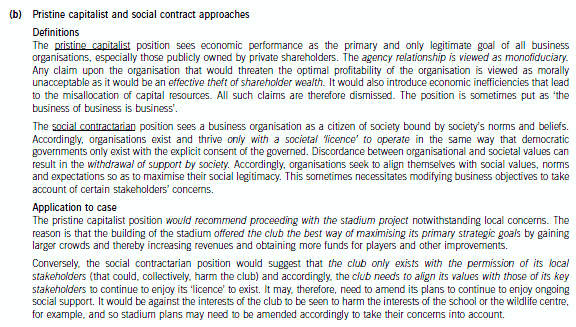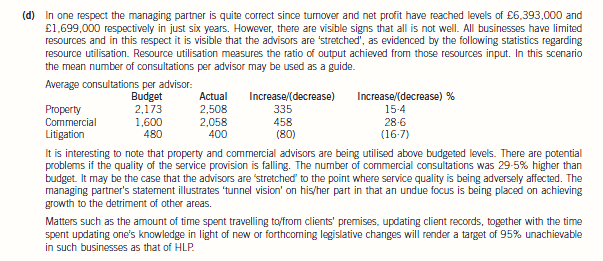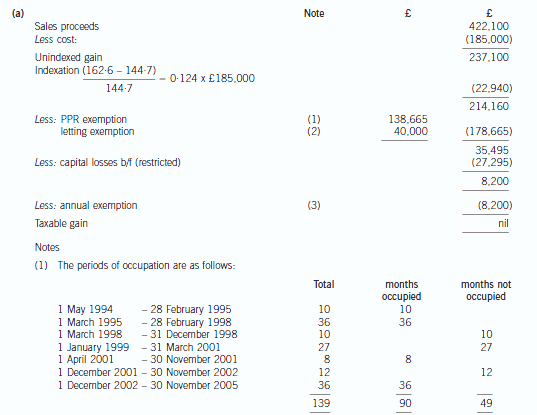ACCA考试P4科目每日一练(2019-01-04)
发布时间:2019-01-04
特许公认会计师公会(The
Association of Chartered Certified Accountants)简称ACCA,成立于1904年,是目前世界上领先的专业会计师团体,也是国际学员最多、学员规模发展最快的专业会计师组织。今天我们要看的就是ACCA考试中P4科目的练习题,希望大家能从每天的练习题中提升自己。
Question:In some cases, society
can gain by restricting imports up to the point at which the benefit of the
last import equals its cost to society as a whole. A tariff set to achieve this
result is called:
A. A deflationary tariff
B. A welfare tariff
C. A marginal tariff
D. An optimal tariff
The correct answer is: An optimal tariff.
The optimal tariff argument
provides a demonstration of the possibility of gains in welfare from a tariff.
备考之路漫长艰辛,需要大家持之以恒,每天要进行复习,切忌三天打鱼两天晒网,51题库考试学习网会一直在您的身边,支持您,陪伴您。祝愿大家早日功成名就!!!
下面小编为大家准备了 ACCA考试 的相关考题,供大家学习参考。
(b) Compare and contrast Gray, Owen and Adams’s ‘pristine capitalist’ position with the ‘social contractarian’
position. Explain how these positions would affect responses to stakeholder concerns in the new stadium
project. (8 marks)

(d) The managing partner of HLP stated at a recent partners’ meeting that ‘every advisor should aim to ensure that
95% of all hours he/she works are billed to clients. This will ensure that we remain both profitable and
competitive’.
Required:
Discuss the statement of the managing partner, drawing attention to any concerns that you may have
regarding the statement. (6 marks)

3 Airtite was set up in 2000 as a low cost airline operating from a number of regional airports in Europe. Using these
less popular airports was a much cheaper alternative to the major city airports and supported Airtite’s low cost service,
modelled on existing low cost competitors. These providers had effectively transformed air travel in Europe and, in so
doing, contributed to an unparalleled expansion in airline travel by both business and leisure passengers. Airtite used
one type of aircraft, tightly controlled staffing levels and costs, relied entirely on online bookings and achieved high
levels of capacity utilisation and punctuality. Its route network had grown each year and included new routes to some
of the 15 countries that had joined the EU in 2004. Airtite’s founder and Chief Executive, John Sykes, was an
aggressive businessman ever willing to challenge governments and competitors wherever they impeded his airline and
looking to generate positive publicity whenever possible.
John is now looking to develop a strategy which will secure Airtite’s growth and development over the next 10 years.
He can see a number of environmental trends emerging which could significantly affect the success or otherwise of
any developed strategy. 2006 had seen fuel costs continue to rise reflecting the continuing uncertainty over global
fuel supplies. Fuel costs currently account for 25% of Airtite’s operating costs. Conversely, the improving efficiency of
aircraft engines and the next generation of larger aircraft are increasing the operating efficiency of newer aircraft and
reducing harmful emissions. Concern with fuel also extends to pollution effects on global warming and climate
change. Co-ordinated global action on aircraft emissions cannot be ruled out, either in the form. of higher taxes on
pollution or limits on the growth in air travel. On the positive side European governments are anxious to continue to
support increased competition in air travel and to encourage low cost operators competing against the over-staffed
and loss-making national flag carriers.
The signals for future passenger demand are also confused. Much of the increased demand for low cost air travel to
date has come from increased leisure travel by families and retired people. However families are predicted to become
smaller and the population increasingly aged. In addition there are concerns over the ability of countries to support
the increasing number of one-parent families with limited incomes and an ageing population dependent on state
pensions. There is a distinct possibility of the retirement age being increased and governments demanding a higher
level of personal contribution towards an individual’s retirement pension. Such a change will have a significant impact
on an individual’s disposable income and with people working longer reduce the numbers able to enjoy leisure travel.
Finally, air travel will continue to reflect global economic activity and associated economic booms and slumps together
with global political instability in the shape of wars, terrorism and natural disasters.
John is uncertain as to how to take account of these conflicting trends in the development of Airtite’s 10-year strategy
and has asked for your advice.
Required:
(a) Using models where appropriate, provide John with an environmental analysis of the conditions affecting the
low cost air travel industry. (12 marks)
(a) Environmental Analysis
Clearly, both the macro-environment and the industry environment facing Airtite are becoming more challenging and scanning
the environment and understanding the relative significance of the challenges is a key step in developing a future strategy to
deal with it. Many models and tools and techniques are available to assess the size of the competitive threats facing Airtite.
One of the earlier scanning models looks to measure whether the environment an organisation faces is becoming more
complex and more dynamic. Evidence from the scenario suggests both are occurring and this means it is becoming
increasingly difficult to predict the future nature of competition from what has happened in the past. Airtite’s future is linked
to an increasingly global environment and many conflicting and contradictory factors require the company to develop a
process through which these factors are considered on a regular and systematic basis.
Johnson and Scholes suggest there are five steps in terms of environmental analysis:
Step 1 Audit of environmental influences
Step 2 Assessment of the nature of the environment
Step 3 Identification of the key environmental forces
Step 4 Identification of competitive position
Step 5 Identification of the principal opportunities and threats
Systematic consideration of each of these steps leads to an understanding of the strategic position of the firm.
A PESTEL analysis is part of the process of environmental appraisal and it is important for John to recognise those parts of
its environment it can influence. All too often firms can regard themselves as ‘victims’ of the chosen environment, failing to
recognise that through their strategic decisions they can profoundly change the competitive environment for their current or
potential competitors. A good PESTEL analysis inevitably links into an informed SWOT analysis. In both instances it is
necessary to isolate the key forces causing environmental change – simply creating a long list of factors may simply convince
you of your inability to change the situation.
Once having decided which are the critical factors, it is then necessary to decide on the likelihood of a particular
environmental change occurring and the significance of its impact on the firm. Matching the competitive capability of the firm
against the attractiveness of the business sector Airtite is operating in will provide an understanding of the firm’s competitive
position and the options open to it. Many other models and tools and techniques are available, including Porter’s five forces,product life cycle analysis and scenario building to generate alternative strategic responses.
1 Stuart is a self-employed business consultant aged 58. He is married to Rebecca, aged 55. They have one child,
Sam, who is aged 24 and single.
In November 2005 Stuart sold a house in Plymouth for £422,100. Stuart had inherited the house on the death of
his mother on 1 May 1994 when it had a probate value of £185,000. The subsequent pattern of occupation was as
follows:
1 May 1994 to 28 February 1995 occupied by Stuart and Rebecca as main residence
1 March 1995 to 31 December 1998 unoccupied
1 January 1999 to 31 March 2001 let out (unfurnished)
1 April 2001 to 30 November 2001 occupied by Stuart and Rebecca
1 December 2001 to 30 November 2005 used occasionally as second home
Both Stuart and Rebecca had lived in London from March 1995 onwards. On 1 March 2001 Stuart and Rebecca
bought a house in London in their joint names. On 1 January 2002 they elected for their London house to be their
principal private residence with effect from that date, up until that point the Plymouth property had been their principal
private residence.
No other capital disposals were made by Stuart in the tax year 2005/06. He has £29,500 of capital losses brought
forward from previous years.
Stuart intends to invest the gross sale proceeds from the sale of the Plymouth house, and is considering two
investment options, both of which he believes will provide equal risk and returns. These are as follows:
(1) acquiring shares in Omikron plc; or
(2) acquiring further shares in Omega plc.
Notes:
1. Omikron plc is a listed UK trading company, with 50,250,000 shares in issue. Its shares currently trade at 42p
per share.
2. Stuart and Rebecca helped start up the company, which was then Omega Ltd. The company was formed on
1 June 1990, when they each bought 24,000 shares for £1 per share. The company became listed on 1 May
1997. On this date their holding was subdivided, with each of them receiving 100 shares in Omega plc for each
share held in Omega Ltd. The issued share capital of Omega plc is currently 10,000,000 shares. The share price
is quoted at 208p – 216p with marked bargains at 207p, 211p, and 215p.
Stuart and Rebecca’s assets (following the sale of the Plymouth house but before any investment of the proceeds) are
as follows:
Assets Stuart Rebecca
£ £
Family house in London 450,000 450,000
Cash from property sale 422,100 –
Cash deposits 165,000 165,000
Portfolio of quoted investments – 250,000
Shares in Omega plc see above see above
Life insurance policy note 1 note 1
Note:
1. The life insurance policy will pay out a sum of £200,000 on the death of the first spouse to die.
Stuart has recently been diagnosed with a serious illness. He is expected to live for another two or three years only.
He is concerned about the possible inheritance tax that will arise on his death. Both he and Rebecca have wills whose
terms transfer all assets to the surviving spouse. Rebecca is in good health.
Neither Stuart nor Rebecca has made any previous chargeable lifetime transfers for the purposes of inheritance tax.
Required:
(a) Calculate the taxable capital gain on the sale of the Plymouth house in November 2005 (9 marks)

Note that the last 36 months count as deemed occupation, as the house was Stuart’s principal private residence (PPR)
at some point during his period of ownership.
The first 36 months of the period from 1 March 1995 to 31 March 2001 qualifies as a deemed occupation period as
Stuart and Rebecca returned to occupy the property on 1 April 2001. The remainder of the period will be treated as a
period of absence, although letting relief is available for part of the period (see below).
The exempt element of the gain is the proportion during which the property was occupied, real or deemed. This is
£138,665 (90/139 x £214,160).
(2) The chargeable gain is restricted for the period that the property was let out. This is restricted to the lowest of the
following:
(i) the gain attributable to the letting period (27/139 x 214,160) = £41,599
(ii) £40,000
(iii) the total exempt PPR gain = £138,665
i.e. £40,000.
(3) The taper relief is effectively wasted, having restricted losses b/f to preserve the annual exemption.
声明:本文内容由互联网用户自发贡献自行上传,本网站不拥有所有权,未作人工编辑处理,也不承担相关法律责任。如果您发现有涉嫌版权的内容,欢迎发送邮件至:contact@51tk.com 进行举报,并提供相关证据,工作人员会在5个工作日内联系你,一经查实,本站将立刻删除涉嫌侵权内容。
- 2019-01-04
- 2019-01-04
- 2019-03-16
- 2019-03-22
- 2019-03-22
- 2019-01-04
- 2019-03-16
- 2019-01-04
- 2019-01-04
- 2019-01-04
- 2019-03-22
- 2019-03-16